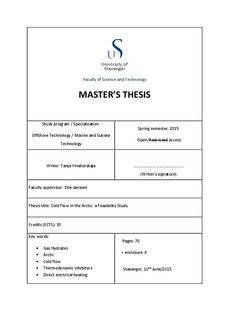| dc.description.abstract | As global energy demands continue to grow, the oil and gas industry is challenged to keep up the pace. The more easily accessible source of energy are getting scarcer, forcing the oil and gas industry to move into deeper waters and harsher environments. Development of Arctic shelf reserves is one of the areas oil and gas production can be maintained through. The Arctic shelf may become a significant source for long term production growth. However, severe Arctic conditions – the difficult ice conditions, challenging weather and lack of infrastructure – demand a different approach and technologies.
Gas and oil production in the Arctic is associated with the necessity of long distance transport causing transported natural gas and water to form gas hydrates. Hydrate formation followed by accumulation forms a slug. As the result, it leads to pipeline restriction and blockage. Clearly, these slugs will hinder the hydrocarbons to flow. To avoid this more and more attention has been paid to develop flow assurance approaches to prevent the formation of hydrate plugs.
Using a case study, this master thesis focuses on comparing employment of the innovative technology to avoid gas hydrates initiation and agglomeration – cold flow – in the Arctic with two conventional ones. Injection of thermodynamic inhibitors and direct electrical heating represent conventional technologies to tackle the hydrates in the case study. All the named techniques are applied to a fictional field development in the Arctic and analyzed on basis of their design, their environmental impact and challenges each of the methods has to face in the Arctic. Economical evaluation of hydrate preventing techniques is an essential part of this case study and includes capital and operational expenditure of employing each of the methods.
This master thesis concludes that the cold flow technology is the most favorable solution for the Arctic compared to the other technologies discussed in the report. Its simple design, low cost, good environmental performance, low maintenance and the potential to be installed on the distances longer than 200 kilometers makes it very attractive not only for the future field developments in the Arctic but also in the other different areas of oil and gas industry. | nb_NO |
